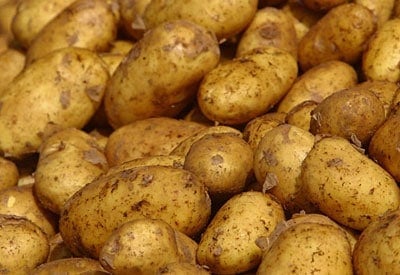A cool-season vegetable, potatoes (Solanum tuberosum) offer organic gardeners everything they could want – easy to grow, long storage life and an enormous selection of varieties. They’re also a good source of fiber and a powerhouse of nutrition. Potatoes contain vitamins A and B; minerals like iron, zinc, potassium, magnesium, and calcium; and several antioxidants.
Their only downside is that store bought potatoes carry more pesticides than most vegetables. They get sprayed with all kinds of nasty fungicides, herbicides and pesticides, even before they’re planted, and then they get sprayed again. Worse the chemical residues tend to be absorbed in the skin and flesh. So what can you do. Why not grow organic potatoes at home? It’s not hard and you’ll know the spuds you feed your family are safe to eat — just the way they should be!
Fun Fact: This starchy, tuberous crop was first grown by the Incas in the Andes Mountains of Peru.
Quick Guide: Planting, Growing & Harvesting Potatoes
- Plant early in spring using certified disease-free tubers
- Needs full sun and loose, nutrient-rich soil that’s free of rocks
- Add soil to the base of the plant throughout the summer season
- Harvest new potatoes when flowers open; tubers are mature when tops die
- Pests and diseases include Colorado potato beetle, aphids, cutworm, flea beetles, wireworms, black heart, common scab, late blight, and gophers

BUILD YOUR SOIL
Soil Amendments
Planet Natural offers the organic amendments that your plants need to thrive.
View allSite Preparation
Potatoes require sandy, fertile, fast-draining soil. The tubers will become deformed in poor or rocky soil. Keep the soil moist but not soggy, and do not allow it to dry out. Water deeply as temperatures begin to rise. They require moderate levels of nitrogen (N), phosphorus (P), potassium (K), calcium and sulfur. Prior to planting, mix plenty of organic compost into your garden plot.
Tip: Spuds are a favorite food of gophers. To prevent damage and destruction, plant spuds above ground in our Geobin® Composter.
How to Plant
Plant potatoes in early spring for a summer crop, in late summer or early fall for a winter/spring crop in mild winter regions. Set tuber pieces 2 inches deep, 1-1/2 feet apart.
Add loose soil as the plant grows, taking care not to cover stems completely. Mulching with straw reduces pest problems and improves yields.
Several serious potato diseases are spread from infected tubers. Only purchase seed that is certified disease-free.
Do NOT plant tubers purchased from the supermarket. In most cases, they will be treated with a chemical sprout inhibitor.

Harvesting and Storage
Harvest new potatoes when flowers begin to open. Pull aside earth around the base of the plants, and gently pick tubers. As soon as tops die down (90-120 days, depending on variety and climate), spuds are ready to harvest. If weather is not too warm or wet, tubers will keep in the ground for several weeks. Dig them up before the first frost.
After curing, store the tubers in a cool, dry place such as the cellar. Storage is easy for the first couple of months. After that, check often for spoilage. Do NOT keep in a plastic bag and use nicked or bruised root crops first.
Can You Eat Potatoes with Scabs On Them?You bet! Affected spuds, while unsightly, are safe to eat. Just cut away the corky spots from skin and/or flesh and prepare as you normally would. |
Insect & Disease Problems
The Colorado potato beetle is a common insect pest of potatoes. Symptoms include skeletonized leaves and defoliated plants. Other pests include aphids, cutworm, flea beetles and wireworms.
Spinosad, the active ingredient in Monterey® Garden Insect Spray, is a relatively new biological pest control that can be effectively used to combat potato bugs. Mix 4 Tbsp per gallon of water and apply to both upper and lower surfaces of plant foliage.
Common diseases include black heart (streaks inside tubers), common scab (russet skin), early and late blight (dark spots on leaves), and mosaic virus (mottled light and dark green leaves).
Seed Saving Instructions
Plants are grown from tuber cuttings, rarely from seed.











